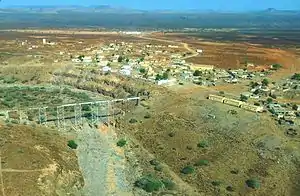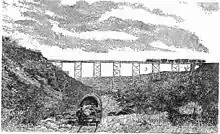Holhol
Holhol (Somali: Hollholl, Arabic: حلحول) is a town in the Ali Sabieh Region of Djibouti. It is located 44 kilometres (27 miles) south-west of the capital Djibouti City, at an altitude of 450m. Holhol enjoys a semi-arid climate (Köppen: BSh). The surrounding district is rich in both livestock and fledgling agriculture. It is notable for being the birthplace of Cheik Osman Waiss a nationalist and anti-colonial where he began his movement.
Holhol
| |
|---|---|
Town | |
 | |
 Holhol Location in Djibouti | |
| Coordinates: 11°18′35″N 42°55′45″E | |
| Country | |
| Region | Ali Sabieh |
| Area | |
| • Total | 0.40 km2 (0.15 sq mi) |
| Elevation | 450 m (1,480 ft) |
| Population | |
| • Total | 3,000 |
| Climate | BSh |
History

The Holhol area has been inhabited since ancient times with nomadics sometimes stopping here for water on the way to the town of Zeila, Tadjoura and after the signing treaties in 1894 with the then ruling Issa Somali Sultans, to established a protectorate in the region referred to as French Somaliland. Holhol became an administrative and commercial centre in the 1900s after the construction of the Ethio-Djibouti Railways, the first railway in French Somaliland.
Overview
Holhol is served by a station on the meter gauge Ethio-Djibouti Railway. A notable feature of the meter-gauge railway is a viaduct, 29 meters high and 45 meters long, that was built in 1900. The station is a transit point for commercial goods from Ethiopia. Holhol also has a station on the new standard gauge Addis Ababa–Djibouti Railway.
The town also lies along RN-5 National Highway. It is the seventh largest city in the country.
Additionally, Holhol has a number of primary and secondary schools as well as nurseries. The El-Hajj Hassan Gouled Military Academy is located here. One kilometer from the town is the local college. Nearby towns and villages include Ali Sabieh (33 km), Goubetto (18 km), Ali Adde (23 km), Dasbiyo (18 km) and Chabelley (28 km).
Demographics
As of 2017, the population of Holhol has been estimated to be 3,000. The city inhabitants belong to various mainly Afro-Asiatic-speaking ethnic groups, with the Issa Somali predominant.
Climate
Holhol is located in the central Ali Sabieh Region, and has a Semi-arid climate (BSh) under the Köppen-Geiger system. Weather in Holhol, much like other inland towns in Djibouti, is warm and dry year-round. The average daytime temperatures during the summer months of June and August can rise to 38 °C (100 °F), with a low of 26 °C (78 °F) at night. The weather is cooler the rest of the year, averaging 26 °C (78 °F) during the day and 17 °C (62 °F) at nighttime. The town limited rainfall of 198 mm usually comes with two peaks during March–May and September–October. Holhol's landscape is semi-desert and fairly flat with wadi valleys.[1]
| Climate data for Holhol | |||||||||||||
|---|---|---|---|---|---|---|---|---|---|---|---|---|---|
| Month | Jan | Feb | Mar | Apr | May | Jun | Jul | Aug | Sep | Oct | Nov | Dec | Year |
| Average high °C (°F) | 26.4 (79.5) |
27.2 (81.0) |
29.4 (84.9) |
31.1 (88.0) |
34.5 (94.1) |
36.6 (97.9) |
38.5 (101.3) |
36.2 (97.2) |
33.5 (92.3) |
30.3 (86.5) |
28.0 (82.4) |
27.0 (80.6) |
31.6 (88.8) |
| Average low °C (°F) | 17.0 (62.6) |
18.2 (64.8) |
20.1 (68.2) |
21.0 (69.8) |
23.0 (73.4) |
25.1 (77.2) |
27.5 (81.5) |
26.8 (80.2) |
25.0 (77.0) |
22.0 (71.6) |
19.3 (66.7) |
17.2 (63.0) |
21.9 (71.3) |
| Average rainfall mm (inches) | 5 (0.2) |
9 (0.4) |
25 (1.0) |
37 (1.5) |
14 (0.6) |
7 (0.3) |
11 (0.4) |
35 (1.4) |
29 (1.1) |
13 (0.5) |
7 (0.3) |
6 (0.2) |
198 (7.9) |
| Source: Climate-Data.org, altitude: 450m[1] | |||||||||||||
References
- "Climate: Holhol - Climate graph, Temperature graph, Climate table". Climate-Data.org. Retrieved 25 September 2013.